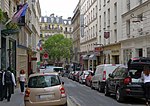The Faculty of Law of Paris (French: Faculté de droit de Paris), called from the late 1950s to 1970 the Faculty of Law and Economics of Paris, is the second-oldest faculty of law in the world and one of the four and eventually five faculties of the University of Paris ("the Sorbonne"), from the 12th century until 1970.
During the Middle Ages, it was, with the faculty of law of the University of Bologna, the oldest one, one of the two most important faculties of law in the world. Pierre Abélard, founder of modern law, was its precursor as a teacher at the cathedral school of Notre-Dame de Paris, Andrea Alciato, founder of legal humanism, was a professor there, and Saint Ivo, patron of the lawyers and "Advocate of the Poors" according to the Catholic Church, has studied there. The prohibition by the Pope of teaching of Roman Law limited, however, its growth, to the benefit of the nearby University of Orléans, where numerous important French people studied law. In 1679, King Louis authorized the teaching of Roman Law. Numerous French intellectuals and revolutionary, like Voltaire, Diderot and d'Alembert, Robespierre, etc. studied there. Between the French Revolution and its dissolution in 1970, numerous important people in France and in the world have taught or studied there, like Victor Hugo, Claude Lévi-Strauss, Tocqueville, and Honoré de Balzac. The faculty of law is also mentioned in classical French literature, in particular in Les Misérables.
At the dissolution of the Sorbonne in 1970, its two main buildings were place du Panthéon and rue d’Assas. Most of its law professors (88 out of 108) decided to perpetuate the faculty of law and economics choose to perpetuate the faculty by creating and joining a university of law offering the same programs within the same two buildings; therefore, they created the "University of Law, Economics and Social Sciences of Paris", now called Panthéon-Assas University.





